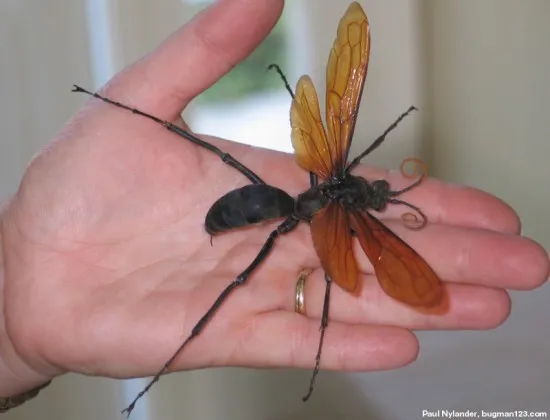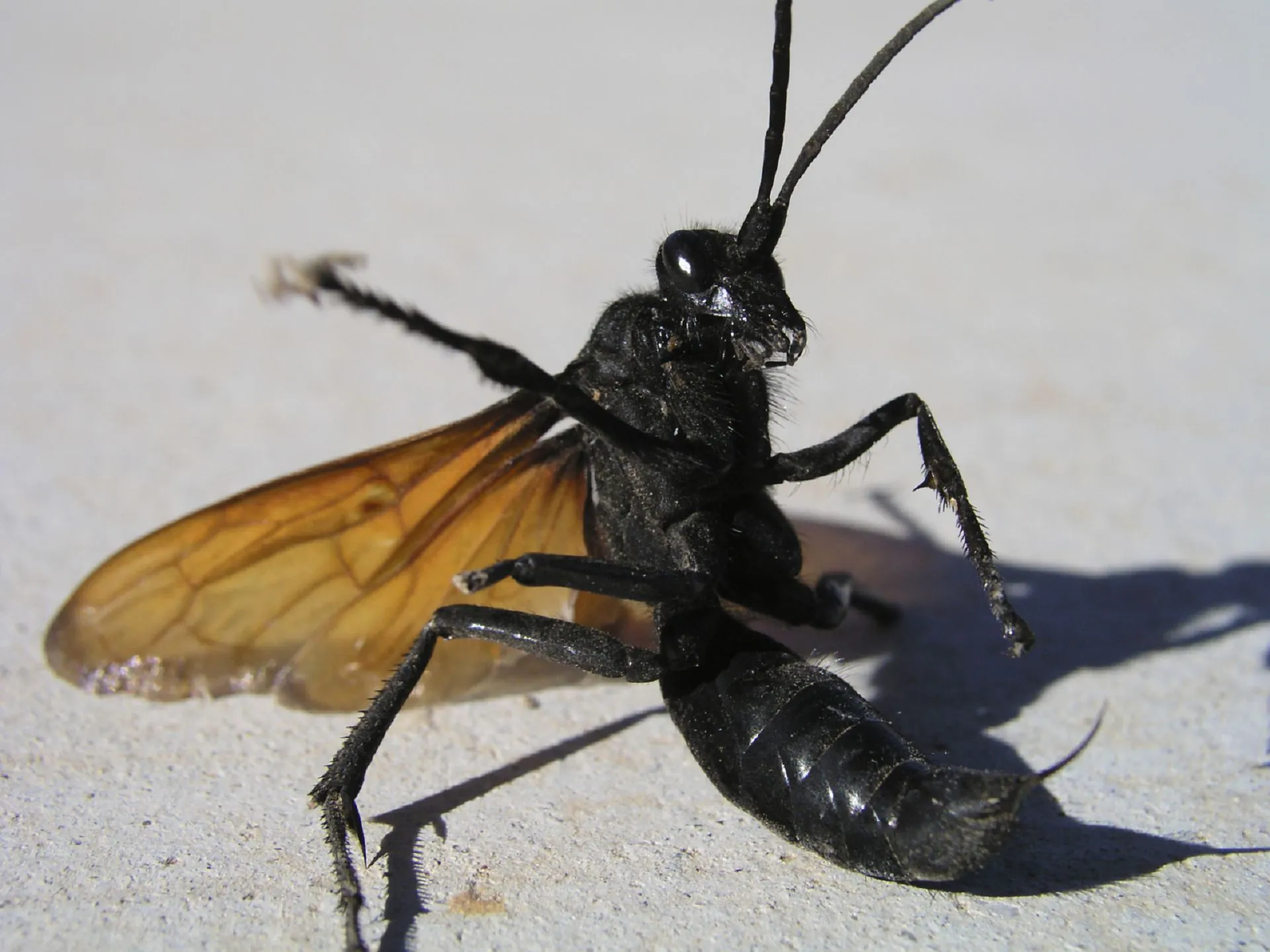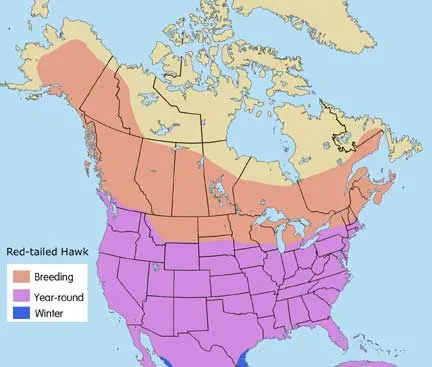What is a Tarantula Hawk
The tarantula hawk is a large, intimidating species of spider wasp known for its striking appearance, excruciating sting, and unique predatory behavior. These wasps are members of the Pompilidae family, characterized by their ability to paralyze spiders and use them as hosts for their larvae. Found primarily in the southwestern United States and parts of South America, tarantula hawks are a fascinating subject of study due to their complex life cycle and the extreme pain associated with their sting. They are also known for their vibrant colors, often displaying a combination of black or dark blue bodies and orange wings, making them easily recognizable in their natural habitat. These wasps are not just predators; they play a vital role in controlling the tarantula population and are an integral part of their ecosystems.
Tarantula Hawk Habitat
Tarantula hawks primarily inhabit arid and semi-arid environments where their primary prey, tarantulas, are found. These areas often include deserts, scrublands, and open woodlands. They prefer environments with sandy or loamy soil suitable for nesting. The wasps require a specific type of habitat. They build nests in the ground and need a relatively open environment for hunting and maneuvering. The availability of tarantulas is crucial. They are a key factor in determining where tarantula hawks thrive. These wasps have adapted to survive in harsh conditions, including extreme heat, and can often be seen actively foraging during the warmest parts of the day.
Tarantula Hawk Geographic Range

The geographic range of tarantula hawks is primarily concentrated in the southwestern United States, extending from California to Texas, and into parts of the southern United States. They are also found throughout much of Mexico and Central and South America. Within this range, they are most abundant in areas with suitable climates and an ample supply of tarantulas. The specific distribution varies depending on the species and local environmental conditions, but generally, they are not found in the colder regions or heavily forested areas. Their range map typically shows a clear preference for warmer climates and regions with less rainfall. They have expanded their range in recent years due to climate change and other environmental factors.
Top 5 Reasons to Fear Tarantula Hawks
While tarantula hawks are not aggressive and typically only sting in self-defense, their sting is notoriously painful, making them a creature to be respected. Here are the top five reasons why you might want to keep your distance from these formidable insects.
The Painful Sting
The sting of a tarantula hawk is considered one of the most painful insect stings in the world. According to the Schmidt sting pain index, the sting ranks a 4, the highest level of pain possible. The pain is described as immediate, excruciating, and often compared to being electrocuted. The pain is intense. It can last for several minutes, even hours, and can be incapacitating. Although the sting is rarely fatal to humans, the level of pain alone is enough to make anyone wary. The venom is designed to paralyze the tarantula. It can cause a significant amount of discomfort to humans.
The Tarantula Hunt

Tarantula hawks are formidable predators, hunting tarantulas that can be many times their size. The hunt itself is a brutal display of nature, as the wasp meticulously stalks the spider, sometimes for hours. The wasp must find a tarantula, which is itself a dangerous predator. The wasp then uses its agility and precision to paralyze the spider with a sting. This is a dangerous task. This hunting behavior showcases the wasp’s strength and determination, and the successful capture of a tarantula is a testament to the tarantula hawk’s predatory prowess. The entire process is a display of raw survival and natural selection.
The Nesting Behavior
After paralyzing a tarantula, the wasp drags the spider back to a burrow or nest. The wasp then lays a single egg on the spider’s abdomen. Once the egg hatches, the larva feeds on the paralyzed, but still living, tarantula, eventually consuming it entirely. This process is disturbing, as the spider is kept alive to sustain the larva. The nesting behavior of tarantula hawks is a grim reminder of the survival of the fittest. The tarantula is used to feed the wasp’s offspring, ensuring the next generation of tarantula hawks continues.
Appearance and Size
Tarantula hawks are large insects, often measuring up to two inches in length. They have a striking appearance, with a black or dark blue body and bright orange or reddish wings. This vibrant coloration serves as a warning to potential predators. The size and appearance of the wasp are a deterrent for animals. Their size, combined with their distinctive colors, makes them easily recognizable and somewhat intimidating. Their overall size and robust build add to their fearsome reputation, as does their ability to move and sting with amazing accuracy.
Defensive Mechanisms

Tarantula hawks are not inherently aggressive. However, they are fiercely defensive if threatened. Their primary defense mechanism is their sting, which they will deploy if they feel threatened or if someone gets too close. The sting is not only incredibly painful but also can cause temporary paralysis. The wasps’ ability to deliver such a potent defense, combined with their size and agility, makes them formidable opponents. The strong defensive capabilities of these insects make them a creature to be avoided, especially when provoked or cornered.
Tarantula Hawks in Popular Culture
Tarantula hawks have gained some notoriety in popular culture due to their striking appearance and painful sting. They have been featured in nature documentaries and other media, which have highlighted their life cycle and predatory behavior. Their fearsome reputation has also led to their portrayal in various works of fiction, where they often appear as symbols of danger or natural power. The public’s fascination with them has resulted in them becoming more recognizable.
Myth vs Reality
Myths and misconceptions surrounding tarantula hawks often exaggerate their aggressiveness and the danger they pose to humans. While their sting is undoubtedly painful, they are not naturally inclined to attack humans. The reality is that these wasps are more interested in their primary prey, tarantulas, and rarely sting unless provoked. However, it’s crucial to understand their behavior and respect their space. The myths and facts surrounding tarantula hawks provide both fascination and fear. It is essential to have a balanced understanding of these creatures.
Where to Find Them

Finding tarantula hawks requires a keen eye and knowledge of their preferred habitats. They are most often seen during the warmer months, actively foraging for tarantulas. Since they are most abundant in areas with a large tarantula population, exploring deserts, scrublands, and open woodlands are the best strategy. Observing them requires patience and caution. They can be found in areas with sandy soil where they build their nests, and they are most active during the day. Look for their distinctive coloration, which helps to differentiate them from other wasps.
North American Locations
In North America, tarantula hawks are commonly found in the southwestern United States. States like Arizona, New Mexico, Texas, and California are known for their high tarantula hawk populations. They are also found in parts of the southeastern United States and into the southern states. Within these regions, parks, nature preserves, and other protected areas often provide a better chance of observing these insects. Knowing their habitat, such as deserts, scrublands, and areas with sandy soil, can help locate them. Carefully observing the ground and surrounding vegetation can increase the chances of seeing these insects.
How to Stay Safe Around Tarantula Hawks
While the tarantula hawk’s sting is infamous, taking precautions can minimize the risk of being stung. The most important step is to avoid disturbing them. Stay a safe distance away. Do not attempt to handle or provoke them. Wearing appropriate clothing when exploring their habitat, like long sleeves and pants, can offer some protection. If a tarantula hawk is encountered, slowly back away without making sudden movements. Understanding their behavior and respecting their space can significantly reduce the chances of a negative interaction. Always be aware of your surroundings when outdoors and mindful of the potential for encountering these fascinating but formidable insects.
